Once you try the exceptional flavors in this reverse sear steak recipe, you won’t want to return to the old way of cooking beef. I was floored when I took my first bite of this steak, and there is no way I’m ever making steak any other way; it’s that good.
We don’t eat beef that often these days, but occasionally, we do have a craving for some. If you want a great steak, try my Steak au Poivre or Grilled T-bone Steak.
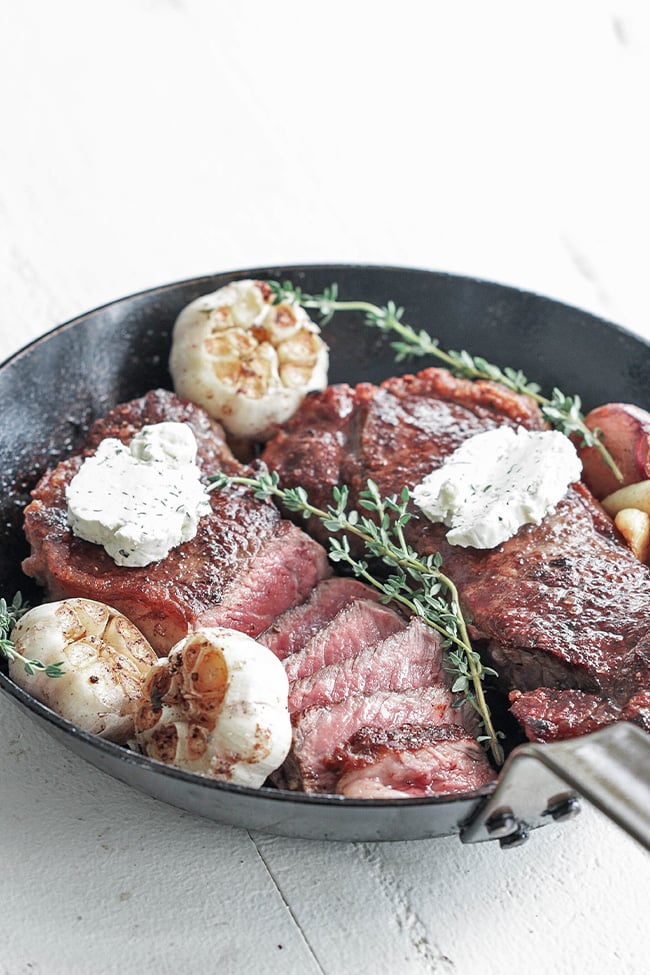
Reverse Sear Steak
Reverse-seared steak is slowly cooked beef in a low-temperature environment until it reaches a desired internal doneness. The steak is then pan-seared or grilled over high heat until perfectly browned. This is a newer trend in preparing meats and has worked exceptionally well.
This procedure allows the cooker to have more control over the steak so that it cooks evenly and is not overdone. The fat softens and begins to break down during the slow cooking period before searing, making the steak incredibly juicy, tender, and flavorful. The steak will dry out outside in this cooking environment, making it optimal for a perfect pan sear and giving off an amazing Maillard crust.
Ingredients and Substitutions
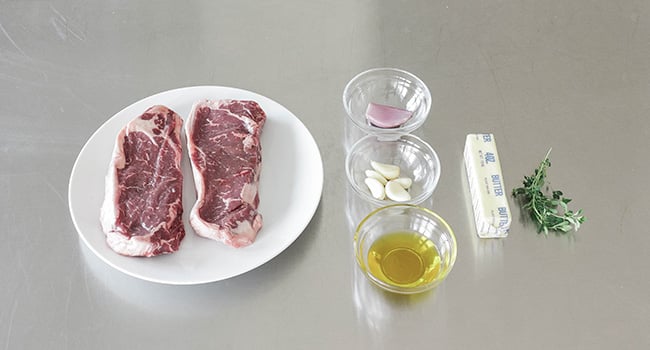
- Steak — Any boneless or bone-in cut of sirloin, filet, ribeye, flank, skirt, top round, hanger, T-bone, or porterhouse steak will work for this. I use a New York Strip Steak. It is best if the steak is at least 1 inch thick, or else it can cook too quickly.
- Oil — To me, olive oil is the best for searing a steak to create the perfect Brown crust. It gives the steak a richer flavor. Other great fats are avocado oil, beef tallow, or clarified butter.
- Butter – This is used to baste the steak for more flavor and browning. I always use unsalted butter in all my cooking and baking to control the sodium content.
- Seasonings – Coarse salt and freshly ground black pepper were used when seasoning the steak.
- Herbs — I used fresh thyme sprigs to enhance the steak’s flavor during searing. Other herbs you could use are rosemary, sage, or oregano.
- Garlic – A few garlic cloves will add beautiful flavors to the dish.
- Shallots – I like to use one shallot when searing the steak for a bit of onion flavor.
How to Reverse Sear a Steak
Start by patting dry the steak on all sides with a paper towel.
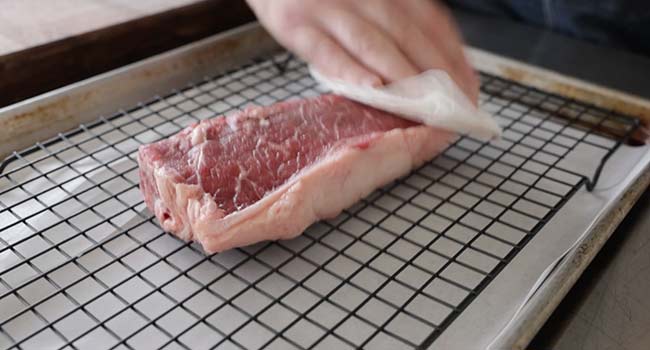
Next, season the steak on all sides with coarse salt and cracked pepper as you would before cooking it. Place it on a rack over a sheet tray and in the refrigerator uncovered for 2 to 24 hours.
This will help season the meat throughout, making every bite delicious. In addition, it will help further dry out the outside of the steak for a fantastic golden brown sear.
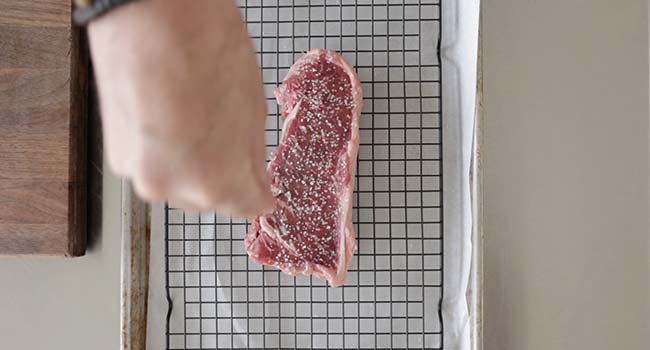
When you’re ready to prepare it, preheat the oven to 200° to 225°. Place the steak on the rack over a sheet tray in the middle of the oven and cook for roughly 45 to 60 minutes.
You want it to reach 100° internally, and the timing in the oven will depend on how thick and heavy the steak is. Add 10° for every final internal temperature doneness. For example, pull it at 110° for medium, 120° for medium-well, and 130° for well done.
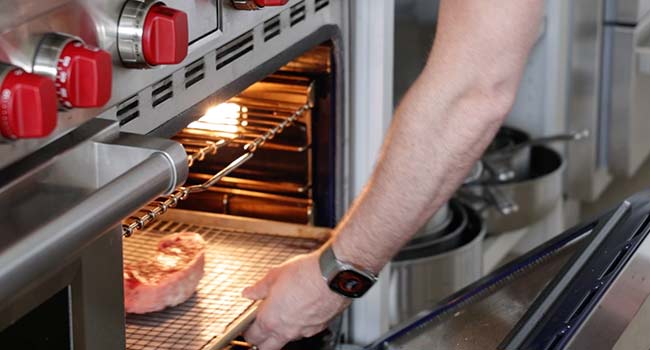
Remove the steak from the oven and briefly set it to the side. The goal is to remove it 25 ° below the final internal cooking temperature. This process will also help further dry out the outside of the steak to make an even better sear.
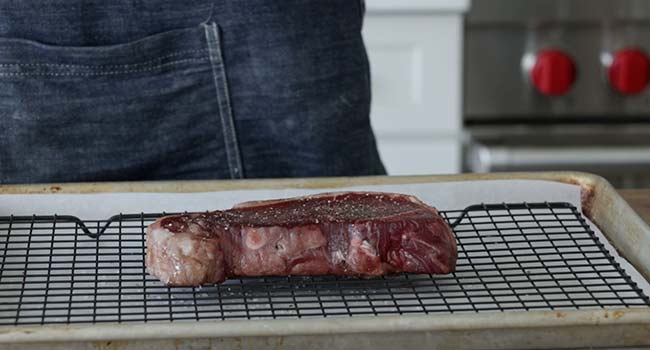
Add the olive oil to a 10” cast iron or carbon steel pan and heat over high heat until the oil smokes lightly. For a medium-rare steak, place the steak in the pan, turn the heat down to medium, and let the steak cook for 1 minute.
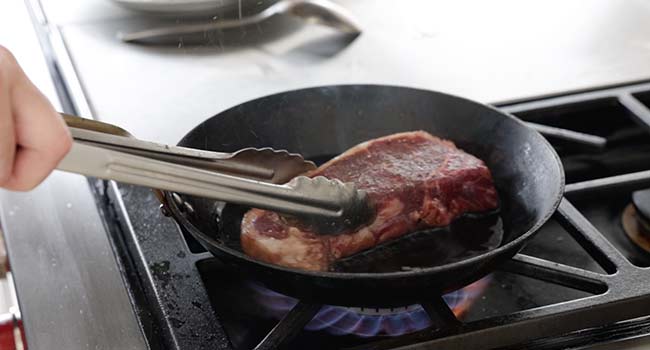
Next, using tongs, move the steak around in a circular motion for 1 minute. Doing this will help completely brown the top of the steak.
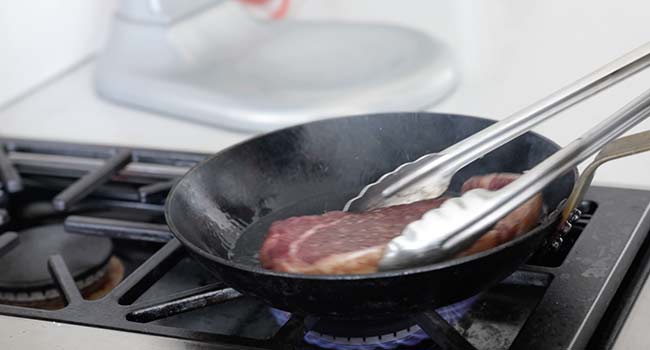
Flip the steak over, turn the heat down to low-medium, and cook it for 1 minute. Then, add the garlic, shallots, thyme, and butter to the pan with the steak. Baste the steak for 2 minutes to help it brown and flavor it more.
Be sure to use a thermometer added directly to the center of the steak to know the exact temperature before removing it.
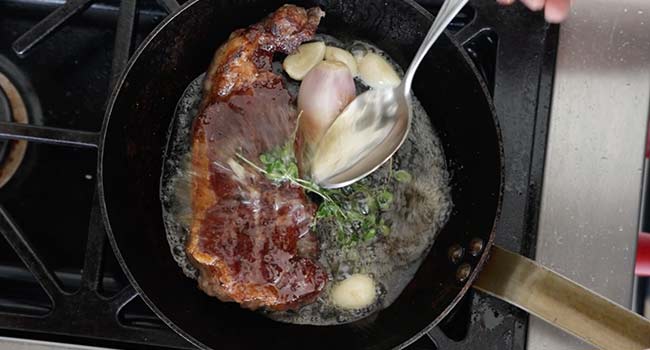
Let the steak rest for 3 to 4 minutes. Slice and serve the steak as is or with some Maître D’ Butter.
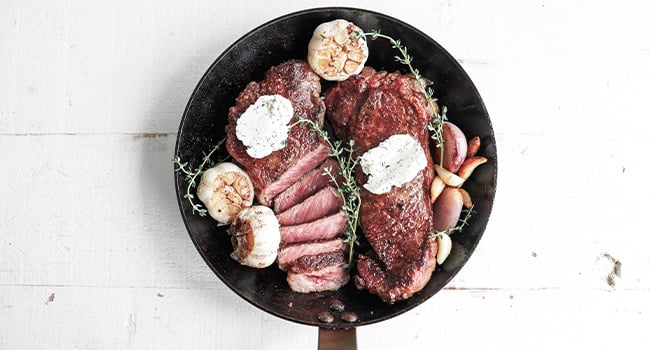
Make-Ahead and Storage
Make-Ahead: Reverse-seared steak is meant to be eaten as soon as it is done cooking.
How to Reheat: This recipe does not reheat well, but if you need to reheat it, re-sear it in a hot pan with lightly smoked oil until warm.
How to Store: Cover and keep in the refrigerator for three days. This recipe will not freeze well.

Chef Notes + Tips
- If you feel like you may have cooked it a bit too long, set it upright when resting it to help heat escape more quickly.
- When the steaks are smaller in weight, you may need to adjust cooking times by 1 minute per side.
- If you let the steak sit seasoned for more than 24 hours, it causes it to begin drying out.
- Cast iron or carbon steel pans are the best for searing steak, but you can use whatever you have.
- Maillard reaction, also known as the browning reaction, is an interaction between sugar and amino acids in the steak when heated to 285°and 350° over high heat, browning the meat to enhance the flavor and add more crispness. This is not the same as caramelizing.
- You will need at least a 12” pan to sear multiple steaks simultaneously.
More Steak Recipes

Video
Reverse Sear Steak Recipe
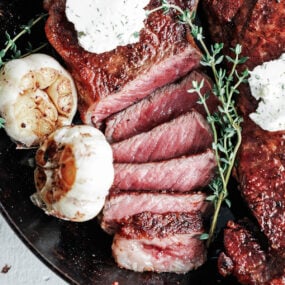
Ingredients
- 2 1-pound New York Strip Steaks
- 2 tablespoons olive oil
- 4 garlic cloves
- 1 peeled shallot
- 12-14 sprigs fresh thyme
- 4 tablespoons unsalted butter
- coarse salt and fresh ground pepper to taste
Instructions
- Start by patting the steak on all sides with a paper towel. This will help to keep the outside of the steak as dry as possible to help create a great crust when searing.
- Next, season the steak on all sides with coarse salt and cracked pepper.
- Place it on a rack over a sheet tray and place it in the refrigerator uncovered for 2 to 24 hours. This pre-seasoning process will allow the salt and pepper to penetrate deep into the meat so that every bite is perfectly seasoned. This works exceptionally well when the steak is at least 1 ½” + thick.
- When you’re ready to prepare it, preheat the oven to 200°. Place the steak on the rack over a sheet tray in the middle of the oven and cook for roughly 45 to 60 minutes. You want it to reach 100° internally, and the timing in the oven will depend on how thick and heavy the steak is.
- Remove the steak from the oven and briefly set it to the side. Add the olive oil to a 10” cast iron or carbon steel pan and heat over high heat until the oil smokes lightly.
- For a medium-rare internal steak, place it in the pan, turn the heat down to medium, and let the steak cook for 1 minute.
- Next, using tongs, move the steak around in a circular motion for 1 minute. Doing this will help completely brown the top of the steak.
- Flip the steak over, turn the heat down to low-medium, and cook it for 1 minute. Then, add the garlic, shallots, thyme, and butter to the pan with the steak.
- Baste the steak with a spoon for 2 minutes to help brown and flavor more. Remove the steak once it reaches 120° to 125° internally for medium-rare.
- Let the steak rest for 3 to 4 minutes. Slice and serve it as is or with some Maître D’ Butter.


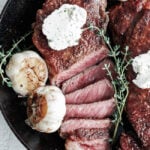
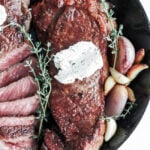

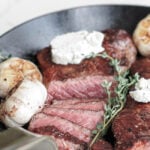
I made this tonight–first time trying reverse sear–and it was amazing. I had a 1.5 inch strip steak, salted it while leaving it on the counter to get to room temp. I used a leave-in meat thermometer to get it up to 100 degrees. I rested it for about 10 minutes, and then pan seared it as directed in a cast iron pan. I also had never basted a steak in butter and herbs before (usually just sprinkled the herbs and onion and garlic powder before cooking). It was AMAZING. I rested it another 10 minutes after, and it was a perfect medium rare. My fiancé and I enjoyed it immensely. Thanks Chef!
Thank you!!
Did this test myself an put the results on my own page. Absolutely fantastic! Love all you put up here and have added many of your recipes to my own.
This recipe makes a much better steak than I have ever had in a restaurant !
Fantastic! So glad you enjoyed it!
Will this work on a 1 inch strip steak?
for sure. Thermometer is key.